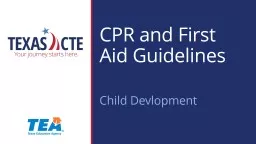

Child Devlopment When Emergencies Arise Emergencies happen all too often and early intervention can save a life CPR and first aid skills are important for caregivers and parents to know Cardiopulmonary Resuscitation Skills ID: 910643
Download Presentation The PPT/PDF document "CPR and First Aid Guidelines" is the property of its rightful owner. Permission is granted to download and print the materials on this web site for personal, non-commercial use only, and to display it on your personal computer provided you do not modify the materials and that you retain all copyright notices contained in the materials. By downloading content from our website, you accept the terms of this agreement.
Slide1
CPR and First Aid Guidelines
Child
Devlopment
Slide2Slide3When Emergencies Arise
Emergencies happen all too often and early intervention can save a life
CPR and first aid skills are important for caregivers and parents to know
Slide4Cardiopulmonary Resuscitation Skills
(CPR)
Slide5What is CPR?
CPR combines rescue breathing and chest compressions
Rescue breathing provides oxygen to the person's lungs
Chest compressions keep oxygen-rich blood flowing until the heartbeat and breathing can be restored
Slide6Five Links in the Adult Chain of Survival
Slide7CPR Instructional Video
Hands-Only Instructional Video on CPR
(click on link)
Slide8What is an Automated External Defibrillator (AED)?
An automated external defibrillator (AED) is a portable device that checks the heart rhythm
Learning how to use an AED and taking a CPR course are helpful
Slide9Texas Guidelines
In Texas, a caregiver trained in CPR must be on duty at all times in a child care facility
Slide10CPR – Child 1 to 8 years old
Slide11Check for Responsiveness
Check for responsiveness
If there is no response, shout for help
Carefully place the child on his or her back
Slide12Chest Compression
Perform chest compressions
Slide13Child Note Breathing
Open the airway
Look, listen and feel for breathing
Continue CPR
Slide14First Aid
Slide15First Aid Kit
A good first aid kit should always be checked and periodically restocked
Slide16Using First Aid
Caregivers should complete basic first aid training before beginning child care employment
Slide17Handling Medical Emergencies
Diluting or removing poisons from the child’s body
Preventing shock
Treating burns properly Immobilizing head and back injuries
Caregivers must be trained in first aid to handle medical emergencies such as:
Preventing severe blood loss
Helping the child to maintain breathing
Slide18First Aid Techniques
Helping the Child to Maintain Breathing
Time is very important when dealing with an unconscious child who is not breathing
Permanent brain damage or even death can occur!Preventing Severe Blood Loss
First aid for severe bleeding is to apply direct pressure firmly to the wound with a clean dressing held in place by the hand of an adult
Slide19First Aid Techniques
Preventing Shock
Keep the child laying flat on the backUse a blanket
If the child is thirst, moisten the lipsGet medical help as soon as possible
Poisons
It is important to dilute the poison or remove the poison from the body before the body absorbs it
Slide20First Aid Techniques
Head and Back Injuries
Do not move the child other than life-threatening circumstancesTreat for shock
Call for emergency medical assistance
Treating Burns Properly
Do not chill the burn or submerge the child in cold water
Cover the burned areas with a loose, dry, sterile dressing
Do not use ointments or antiseptics
Slide21What to do about conscious choking
(click on poster)
Slide22What is the universal distress signal for choking?
Slide23Hand Washing
After providing first aid care
Immediately after being exposed to contaminants, such as blood or other body fluids
After using the restroomBefore and after handling food
Slide24Reporting Accidents and Injuries
Reporting incidents should be done according to established center policies
Slide25Emergency Contact Sheet
(click on poster)
Slide26Babysitting Basics
(click on link)
Babysitting Basics Online Course: Overview
Slide27Questions?
Slide28References and Resources
Images:
American Accreditation Health Care Commission
http://www.urac.org
American Red Cross
Conscious choking poster.
http://www.redcross.org/images/MEDIA_CustomProductCatalog/m4240176_ConsciousChokingPoster_EN.pdf
American Red Cross
Hand washing poster.
http://www.redcross.org/images/MEDIA_CustomProductCatalog/m4240174_HandWashingPoster_EN.pdf
Microsoft Clip Art: Used with permission from Microsoft.
National Institutes of Health
http://www.nih.gov/
Textbook:
Decker, Celia.
Child development; early stages through age 12
. 7th. Tinley Park, IL:
Goodheart
-Willcox, 2011.
Websites:
American Heart Association
What is CPR?
http://www.heart.org/HEARTORG/CPRAndECC/WhatisCPR/What-is-CPR_UCM_001120_SubHomePage.jsp
Slide29References and Resources
Kidshealth
Every parent should know how and when to administer CPR. When performed correctly, CPR can save a child’s life by restoring breathing and circulation until advanced life support can be given by health care providers.
http://kidshealth.org/parent/firstaid_safe/emergencies/cpr.html
Medline Plus
CPR – Child 1 to 8 years old
http://www.nlm.nih.gov/medlineplus/ency/presentations/100215_1.htm
YouTube™:
American Heart Association
Official 2012 Hands-Only CPR Instructional Video
http://youtu.be/zSgmledxFe8
American Red Cross
Babysitting Basics Online Course: Overview
http://youtu.be/-sIMpZJaPZ4